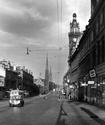 To the casual observer, Glasgow, with its skyline punctuated by church spires and towers, gives the impression of being a religious city. The view looking down Great Western Road from Kelvinbridge is dominated by the spires belonging to Lansdowne Church and St Mary’s Episcopal Cathedral, one slim and elegant, the other displaying more of a middle aged spread. These churches formed part of a diverse religious heritage encompassing major denominations from the Roman Catholic, Church of Scotland, Episcopal, Baptist and Congregational churches to smaller evangelical groups such as the Brethren Church. The Jewish Synagogue, opened in 1879, continued to flourish.
To the casual observer, Glasgow, with its skyline punctuated by church spires and towers, gives the impression of being a religious city. The view looking down Great Western Road from Kelvinbridge is dominated by the spires belonging to Lansdowne Church and St Mary’s Episcopal Cathedral, one slim and elegant, the other displaying more of a middle aged spread. These churches formed part of a diverse religious heritage encompassing major denominations from the Roman Catholic, Church of Scotland, Episcopal, Baptist and Congregational churches to smaller evangelical groups such as the Brethren Church. The Jewish Synagogue, opened in 1879, continued to flourish.
 It might be thought that the effects of two World Wars and an increasingly secular society would adversely affect religion, but church membership continued to rise until the 1950s although these members became less regular in patterns of attendance. Nonetheless, Sunday remained a religious day and individual ministers could attract large congregations with, for example, people queuing in the streets around Wellington Church to hear the Rev Dr George Morrison preach.
It might be thought that the effects of two World Wars and an increasingly secular society would adversely affect religion, but church membership continued to rise until the 1950s although these members became less regular in patterns of attendance. Nonetheless, Sunday remained a religious day and individual ministers could attract large congregations with, for example, people queuing in the streets around Wellington Church to hear the Rev Dr George Morrison preach.
 Religion also played an important role in people's social lives from Sunday School outings to youth groups and the Women's Guild, although the churches faced increasing competition from secular forms of entertainment. In 1955, the Billy Graham Crusade continued the tradition of American evangelists visiting the city established by Moody and Sankey in the 19th century.
Religion also played an important role in people's social lives from Sunday School outings to youth groups and the Women's Guild, although the churches faced increasing competition from secular forms of entertainment. In 1955, the Billy Graham Crusade continued the tradition of American evangelists visiting the city established by Moody and Sankey in the 19th century.